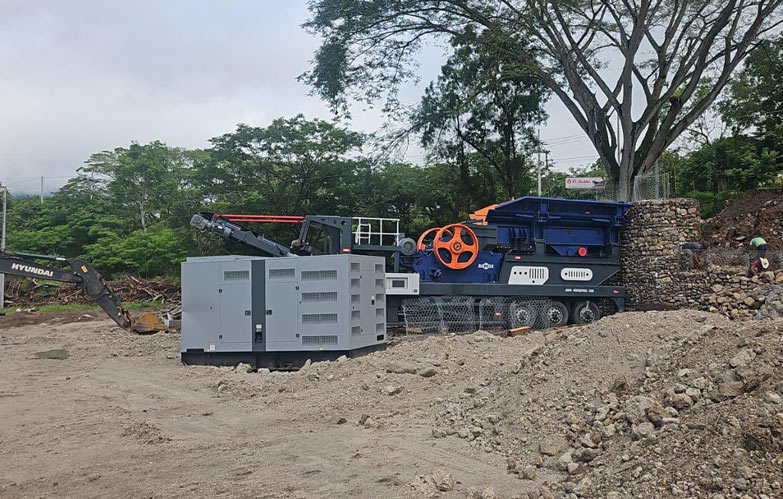In the mining and aggregate industry, raw material characteristics play a critical role in determining the performance and cost of crushing equipment. Contractors and plant operators must carefully consider how variations in hardness, abrasiveness, and moisture content influence the design and pricing of a mobile stone crusher plant(planta trituradora de piedra movil). From smaller regional projects to large-scale mining operations, understanding these factors helps optimize equipment selection, improve efficiency, and manage investment costs effectively.
How Raw Materials Influence Mobile Crusher Selection
Hardness And Abrasiveness
The hardness of the material is one of the most important factors when configuring a stone crusher plant. Harder rocks such as granite or basalt require more robust crushing mechanisms, which may include higher-capacity jaw crushers or cone crushers with reinforced components.
Abrasive materials, such as quartz-rich rocks, can accelerate wear on crusher liners, belts, and other critical parts. To mitigate maintenance costs, an aggregate crusher plant designed for abrasive materials often features wear-resistant steel and replaceable liners.
Moisture Content And Feed Size
Materials with high moisture content, such as river sand or clay-bound aggregates, can affect the efficiency of the crusher and may lead to clogging. Mobile plants intended to handle wet raw materials often include features like vibrating feeders, anti-sticking coatings, or pre-screening systems.
Feed size is also crucial. Larger boulders require jaw or impact crushers with wider feed openings, while smaller stones can be processed by smaller mobile units or secondary crushers. Understanding feed characteristics ensures optimal configuration and avoids unnecessary oversizing of the plant.
Impact On Mobile Stone Crusher Plant Configuration
Crushing Stages
Depending on raw material properties, a mobile stone crusher plant(planta trituradora) may include one or multiple stages:
- Primary Crushing: Suitable for large, hard rocks; typically involves a jaw crusher.
- Secondary Crushing: Refines material size using cone or impact crushers.
- Screening And Sorting: Separates finished aggregates by size, ensuring uniform product quality.
Different raw materials often require adjustments in each stage. For instance, highly abrasive rocks may need additional wear-resistant components in secondary crushing, while soft stones may allow for simpler configurations.
Mobility Considerations
Mobile plants are valued for their flexibility, especially in mining projects or remote construction sites. When processing diverse raw materials, mobility allows operators to adjust plant positioning to accommodate varying feed sources or project layouts. This adaptability ensures consistent production and reduces downtime caused by material handling challenges.
How Raw Materials Affect Stone Crusher Plant Price
Equipment Selection And Investment
Materials that are harder or more abrasive typically necessitate more durable, high-capacity machinery. This increases both the initial mobile stone crusher plant price and maintenance costs over time.
Softer, less abrasive materials may allow for smaller or simpler configurations, reducing investment costs. However, contractors must balance lower initial costs with production capacity requirements to avoid bottlenecks.
Operational Costs
Operational efficiency is also influenced by raw material characteristics. Moisture-heavy or sticky aggregates may increase energy consumption due to higher resistance in the crusher. Abrasive materials require more frequent replacement of wear parts, impacting overall lifecycle costs. An aggregate crusher plant(planta trituradora de agregados) configured appropriately for specific raw materials can minimize these expenses.
Long-Term Value
Investing in the right configuration ensures that a stone crusher plant maintains consistent output and minimizes downtime. Plants designed with material-specific features often have a higher resale value because future buyers recognize their specialized capability and reliability.
Practical Tips For Contractors
- Assess Raw Material Properties: Conduct tests to determine hardness, abrasiveness, and moisture levels before purchasing a mobile crusher.
- Select Appropriate Crushers: Match crusher type and stage configuration to material characteristics to optimize efficiency.
- Consider Wear-Resistant Components: For abrasive materials, invest in high-quality liners and parts to reduce maintenance costs.
- Plan for Mobility: Ensure the plant can be relocated easily to access new raw material sources or adapt to project needs.
- Evaluate Total Cost: Include both initial purchase and long-term operational costs when comparing mobile plant prices.
Conclusion
Raw material characteristics directly impact both the configuration and pricing of a mobile stone crusher plant. Hardness, abrasiveness, moisture content, and feed size all influence equipment selection, crusher stages, and wear part requirements. By understanding these factors, contractors can optimize their aggregate crusher plant for performance, reduce operational costs, and ensure long-term value. Proper planning and material-specific configuration allow a stone crusher plant to deliver consistent, high-quality output, making it a strategic investment in the mining and construction industry.


Comments
No comments yet. Be the first to react!